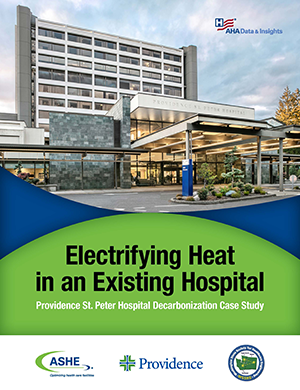Electrifying Heat in an Existing Hospital
Decarbonization Case Study and Preparation Guide
A groundbreaking case study on electrifying an existing hospital building’s thermal load — and a companion guide on starting decarbonization efforts
Available Publications

Electrifying Heat in an Existing Hospital
This groundbreaking analysis conducted by the American Society for Health Care Engineering and Providence St. Peter Hospital establishes the technical and financial feasibility of electrifying the existing hospital building’s thermal load. The case study provides a detailed outline of the steps one hospital is taking to successfully achieve this feat — something once thought impractical by many in the health care facilities management field.
Electrifying Heat in an Existing Hospital is a groundbreaking and comprehensive analysis conducted in partnership with Providence St. Peter Hospital that establishes the feasibility of electrifying the existing hospital building’s thermal load. While previously there has been extensive guidance for decarbonizing new hospital buildings, little information was available about the decarbonization of an existing hospital building. Additionally, there was speculation about the feasibility of electrifying the thermal load and decarbonizing an existing hospital from a technical and financial perspective.
This case study, written by the American Society for Health Care Engineering, shows:
- It is technically feasible to electrify the Providence St. Peter Hospital building’s thermal load:
- The project will need to be done in phases over approximately 10-15 years.
- Decarbonization planning needs to begin early.
- The building must be optimized concurrently with other decarbonization planning, which includes ventilation, energy conservation measures, the building envelope, etc.
- It is financially feasible to electrify Providence St. Peter Hospital’s existing building:
- Electrifying the thermal load would cost around $100/square foot.
- Full decarbonization includes factors beyond the thermal load, however decarbonizing the thermal load has been seen as the most difficult and has the most naysayers. Other systems to decarbonize include:
- Deactivating piped nitrous systems.
- Removing desflurane from drug formulary.
- Electrification of the transportation modes.
- Less waste to the landfill.
- Purchasing renewable energy.
The book provides a detailed outline of the steps one hospital is taking to achieve this feat. Yet, to be clear, this publication is not intended to be a playbook for electrifying any given hospital, nor is it meant to be a benchmark by which other hospitals pursuing this goal should be measured. The path to complete electrification is an extremely complex and bespoke process. Each electrification plan must be tailored to the specific goals of a given health care facility or system as well as regulatory requirements that govern that facility and the needs of the communities it serves. That said, this case study does serve as a success story meant to inspire and demonstrate that this feat, which not so long ago seemed impossible, might be, in fact, within reach.
Table of Contents Overview
- Introduction
- Results
- Facility Description
- Performance and Load Testing
- Decarbonization Studies
- Resilience
- Capital Equipment and Costs
- Construction Phasing

How to Prepare for a Decarbonization Study
This guide outlines the steps a hospital team can take to initiate a decarbonization study at their facility. As a companion piece to the American Society for Health Care Engineering’s book Electrifying Heat in an Existing Hospital, which describes the pathway one existing hospital is taking to achieve decarbonization, this publication provides suggestions to health care executives, facilities managers and sustainability managers on how to start planning, and budgeting, for a transition to clean energy.
Infrastructure investments in a hospital building’s systems that support a safe patient environment can also reduce carbon emissions and life-cycle costs. This monograph outlines the steps a hospital team can take to initiate a decarbonization study. As a companion piece to the American Society for Health Care Engineering’s book Electrifying Heat in an Existing Hospital, which describes the pathway one existing hospital is taking to achieve decarbonization, this piece provides suggestions to health care executives, facilities managers and sustainability managers on how to start planning, and budgeting, for a transition to clean energy.
Insights are shared on how to develop a business case for a decarbonization study at an existing hospital. Recommendations are also made to help define the scope of a decarbonization plan, develop a budget, engage with other important stakeholders and contract with external engineering support.
Topics include:
- The value of decarbonization
- Budgeting
- Internal collaboration
- Contracting with an engineering team
- Financial incentives for energy efficiency
- Sample language for a decarbonization study RFP
- Key deliverables for a decarbonization study



